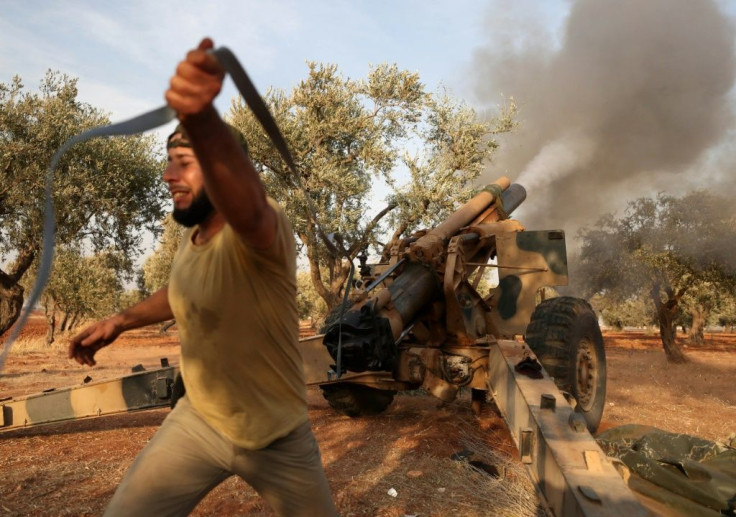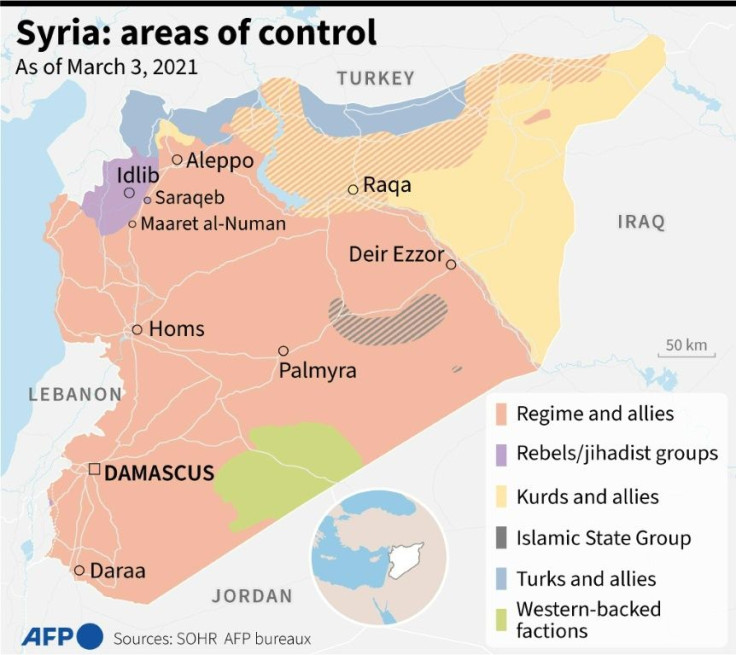Syria's Idlib: What Future For The Rebel Holdout?
Ten years into Syria's war, a large patch of territory in the country's northwest controlled by jihadists and allied rebels is still holding out against the Damascus regime.
Can the Idlib bastion, protected against a military onslaught since a March 2020 ceasefire, continue to survive as its own self-run territory, perhaps a bit like the Palestinian Gaza Strip?
On the border with Turkey, a former Al-Qaeda affiliate as well as a flurry of rebel groups and other jihadists resist government rule in a chunk of territory referred to as Idlib.
The jihadist-dominated bastion is made up of half of Idlib province as well as slivers of adjacent governorates.
Hayat Tahrir al-Sham (HTS) controls the agricultural area and its towns through its influence over the so-called Salvation Government.
Despite HTS claiming it has renounced all ties with Al-Qaeda, the United Nations and European Union consider the group to be "terrorist".
Syria's last major opposition bastion is home to 2.9 million people, of whom two thirds have been displaced from their homes by conflict, the UN says.
Many of those displaced, including those forced to flee other parts of the country, live in camps.

For about a year, fighting has largely halted in and around the area after a ceasefire deal, brokered by Damascus ally Russia and rebel backer Turkey, took hold in March 2020.
But years of successive Russia-backed government bombardment campaigns have chipped away at the opposition stronghold.
From September 2017 to today, jihadists and allied rebels saw their bastion shrink from 9,000 to just 3,000 square kilometres (3,470 to 1,150 square miles), geographer Fabrice Balanche says.
Of the 2.9 million residents, several thousand are said to be jihadist fighters, according to UN estimates.
The region is run by HTS and its 10,000 mostly Syrian fighters, a UN report released last month said.
They control the importation and distribution of gasoline and diesel, pocketing about $1 million a month in trading fuel and energy, it said.
The group is also reported to control distribution of humanitarian aid, "and confiscates portions of these goods to reinforce HTS patronage networks," the report added.
But several other jihadist groups also exist, and there is sometimes infighting.

Among these, the Al-Qaeda-linked Hurras al-Deen, estimated to have 2,000 to 2,500 fighters, according to the UN.
The Turkistan Islamic Party (TIP), whose fighters mostly hail from China's Uighur minority, counts an estimated 3,000 to 4,500 members.
The region has also attracted Western European and Chechen fighters, the Syrian Observatory for Human Rights says.
The Britain-based war monitor also says some Islamic State group cells are present.
Thousands of Turkey-backed rebel fighters are also based in Idlib, and largely co-exist with HTS.
Ankara has deployed thousands of soldiers across Idlib as part of the March 2020 ceasefire deal.
"Any Russian-Syrian offensive against Idlib would run into the Turkish army," a Western diplomat told AFP.
"The Turks have massively invested in the enclave with around 15,000 men."
Turkey, which already hosts at least 3.6 million Syrian refugees, desperately wants to avoid another influx that would spark more popular discontent.
"A new wave of Syrian refugees would present serious political, economic and humanitarian challenges," said analyst Dareen Khalifa of International Crisis Group.
Instead "Ankara is trying to strike a balance between... keeping Idlib out of regime control and thus preventing a flow of refugees -- with jihadists mixed in -- streaming across its border," and maintaining "its relationship with Moscow".
The Syrian regime and its Russian ally, meanwhile, have their eyes on fully securing a key commercial artery running through Idlib called the M4, after gaining partial control in its last military offensive.
Balanche said he could see Turkey agreeing to some concessions, in exchange for being allowed to seize further areas from Syrian Kurdish fighters it views as "terrorists".
President Recep Tayyip "Erdogan wants something in exchange, which I think is more Kurdish territory," he said.
Ankara and its Turkish proxies have already seized large swathes of land from Kurdish forces in several military offensives, the last of which was halted by a Russian-Turkish deal.
But even with some bartering, a rebel bastion could survive as a "Turkish protectorate", Balanche said, to act as a buffer zone on its southern border.
It would be like a "new Gaza Strip," he said.
That is "a narrow strip of land under the control of Islamist groups like HTS, managing a population of refugees, under a drip of international humanitarian aid."
© Copyright AFP 2024. All rights reserved.




















